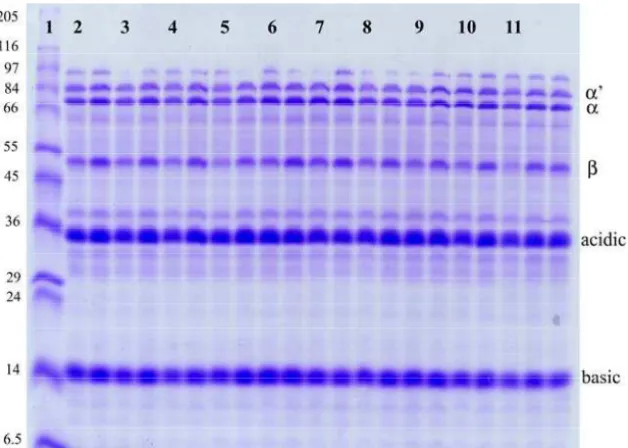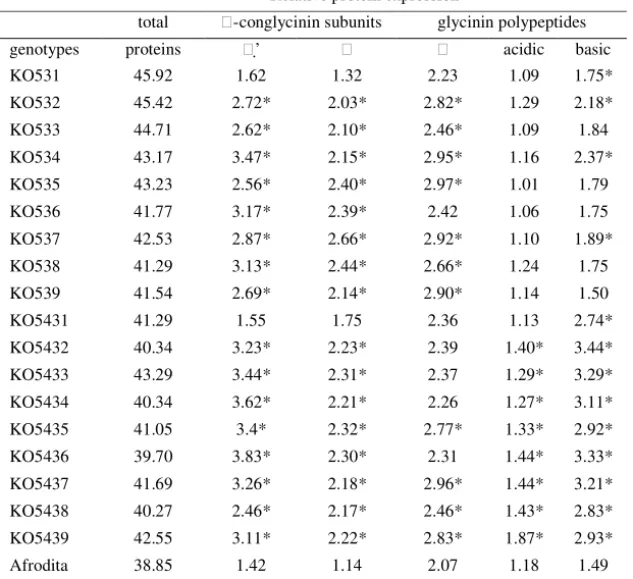______________________________
Corresponding author: Ksenija Taski-Ajdukovic, Maksima Gorkog 30, 21000 Novi Sad, Srbia, phone 021/4898 157,fax: 021/ 421 249,
e-mail: ksenijat@ifvcns.ns.ac.yu
UDC 575:633.34
Original scientific paper
THE MAIN SEED STORAGE PROTEINS AMONG HIGH-PROTEIN SOYBEAN GENOTYPES
Ksenija TAŠKI-AJDUKOVI 1, Vuk OR EVI 2, Miloš VIDI 2, Milka VUJAKOVI 1, Mirjana MILOSEVI 1and Jegor MILADINOVI 2
1National Laboratory for Seed Testing, Novi Sad 2Institute for Field and Vegetable Crops, Novi Sad, Serbia
Taški - Hajdukovi K., V. or evi , M. Vidi , M. Vujakovi , M. Miloševi and J. Miladinovi (2008): The main seed storage proteins
among high .protein soybean genotypes.– Genetika, Vol. 40, No. 1, 9-16.
It is known that the main components of the seed storage proteins contribute to the quality of soybean [Glycine max (L.) Merr.] food products. The objective of this study was to investigate content of the two of them [glycinin (11S) and -conglycinin (7S) fractions] and their respective subunits on the new high-protein soybean genotypes from the Institute for Field and Vegetable Crops, Novi Sad, Serbia. Subunits were resolved by SDS-PAGE and gels were analyzed by scanning densitometry.
polypeptides of glycinin were not significantly higher only in genotypes KO539, KO536, KO538, KO535 and KO533. In conclusion, it appears that among the new high-protein genotypes there are genotypes with different amount of subunits that should be bread in the future for a desired level of the protein components.
Key words: Glycine max, -conglycinin, glycinin, high-proteins
seeds, soybean, storage proteins
INTRODUCTION
Soybean (Glycine max L. (Merr.) is an important crop because its seeds contain high concentrations of protein and oil. Most of the commercially grown soybean cultivars contain about 40% protein and 20% oil. More recently soybeans have been bred to increase seed yield and oil content because it was mainly used for the oil refine for human consumption, whilst protein meal was used as a source of high quality protein for animal husbandry. Nowadays, with increase in the consumption of meat, the demand for protein in animal husbandry has increased and high percent of the protein fraction in soybean seeds is now attributable. Thus breeders released more and more high seed lines for commercial used.
About 70% of the storage proteins in soybean seed are the salt-soluble proteins termed globulins. The globulins consist of 11S, 7S, and 2S fraction. The 11S globulins are referred to as glycinin and the 7S globulins are termed -conglycinin (THANH et al., 1978; DERBYSHIRE et al., 1976). Glycinin accounts for about 60% of storage proteins and -conglycinin the remaining 40%, though there is some variation among soybean cultivars (NIELSEN et al., 1989). Glycinin is hexamer with molecular weight between 320 x 103 and 375 x 103 (B
ADLEY et al., 1975). Each hexamer is composed of two trimers consist of tree monomers. The monomers consist of subunits that are composed of specific acidic (A) polypeptide chain linked by disulfide bonding to a specific basic (B) polypeptide chain and can be one of five subunits (A1aB1b, A2B1a, A1bB1a, A54B3 and A3B4) (YAKLICH, 2001). The -conglycinin is trimer with molecular weight of 150-175 x 103 (THAN et al., 1977). It is formed by various combinations of three nonidentical but homologous polypeptide subunits ( ,' and ) (THAN et al., 1978). The two major storage proteins do not contain many sulfur aminoacids, although glycinin contains more (3 to 4.5%; FUKUSHIMA, 1991) than -conglycinin (less than 1%; DERBYSHIRE et al., 1976).
MATERIAL AND METHOD
Plant materials
Twenty soybean genotypes developed at the Institute for Field and Vegetable Crops in Novi Sad, Serbia were used in the study. The trials were carried out at Institute’s experimental fields in Rimski Sancevi, where the genotypes were developed. The trials were conducted during the 2005 growing season.
Chemicals and reagents
All chemicals and reagents were either Sigma company (St. Louis, MO) or of analytical grade.
Moisture and protein contents
Moisture and protein content were determined by NIR spectroscopy using PERTEN DA 7000.
Extraction of seed protein
Soybean seeds were ground in a Termomix, Worwerk. Forty mg of seed powder were extracted in 1ml of extraction buffer (0.03 M TRIS-HCl pH 8.0 containing 0.01 M -mercaptoethanol. The samples were left for 1 hour at room temperature with vortexing every 10 min. The samples were then centrifuged for 20 min at 11000 g at room temperature. The supernatant contained the total soybean proteins.
Sodium dodecyl sulfate-polyacrylamide gel electrophoresis (SDS-PAGE) The protein content of the supernatant was analyzed according to the Bradford method (BRADFORD, 1976) with bovine serum albumin (BSA) as a standard.
Fifty µl of the extract were mixed with 50 µl of SDS-sample buffer (0.15 M TRIS-HCl, pH 6.8, 3% w/v SDS, 5% v/v -mercaptoethanol, 7% v/v glycerol and 0.03% Bromphenol Blue) and heated for 3 min in a boiling water bath. Solution was cooled to the room temperature and 15 µl of the sample was loaded onto each well. SDS-PAGE was carried out at 25 mA per gel until the tracking day has migrated thought the stacking gel and then at 45 mA per gel until the Bromphenol Blue was at the bottom of the gel. The temperature of 15-20 °C was obtained by circulating tap-water trough the tank buffer.
The gels were stained by incubation in 0.1% Coomassie Brilliant Blue R-250 during 2 hours. When properly stained, the gels were rinsed in gel fixing solution (3 methanol: 1 glacial acetic acid: 6 distilled water).
Quantification of protein fraction by densitometry
The protein bands on the destaned gel were quantitated using ImageJ software. To quantitate the various protein bands from each soybean genotype, the area of specific protein band of a soybean genotype was compared with area of the protein band for control soybean line (Vojvodjanka) and obtained value was relative to that soybean line. The standardized variables were than analyzed by pairwise means comparisons for significance between Afrodita and all other genotypes.
RESULTS AND DISCUSSION
SDS-PAGE profile of soybean seed proteins
In Fig. 1 are shown patterns of total soybean proteins from 10 different high-proteins soybean genotypes on SDS-polyacrylamide gel. The protein bands were similar among all soybean genotypes. The 7S protein fraction was separated into α, α’ and β subunits with molecular weight of 81,000, 74,000 and 50,000, respectively. The 11S protein fraction was separated into acidic and basic subunits. The group of polypeptides near the molecular weight of about 35,000 was a major group of acidic polypeptides. The group of protein bands with molecular weigh values of approximately 14,000 represents basic components.
Quantification of 11S and 7S proteins subunits
Densitometric analysis was used to quantify the subunits of two major soybean seed proteins separated by SDS-PAGE (Table 1).
The genotype KO5439 had the highest value for the acetic polypeptides of glycinin. Those polypeptides were significantly higher in genotypes KO5437, KO5436, KO5438, KO5432, KO5435, KO5433, and KO5434. The basic polypeptides of glycinin were the highest in KO5439, while in the genotypes KO539, KO536, KO538, KO35, and KO533 they did not significantly differ from Afrodita.
Fig 1 SDS-PAGE gel of the total proteins from soybean genotypes
1. Molecular weight markers (kDa), 2-10 protein profile of some tested soybean genotypes 11. cultivar Vojvodjanka
genotypes did not agree totally with total protein content of the seed. The same conclusion was done by YAKLICH, 2001. WILSON (1987) noted that the quality and quantity of subunits and polypeptides may differ in glycinin and β-conglycinin.
Table 1 Relative protein expression of the subunits of glycinin and β-conglycinin and total
seed protein content in high-protein soybean genotypes
Relative protein expression
total -conglycinin subunits glycinin polypeptides
genotypes proteins ’ acidic basic
KO531 45.92 1.62 1.32 2.23 1.09 1.75*
KO532 45.42 2.72* 2.03* 2.82* 1.29 2.18*
KO533 44.71 2.62* 2.10* 2.46* 1.09 1.84
KO534 43.17 3.47* 2.15* 2.95* 1.16 2.37*
KO535 43.23 2.56* 2.40* 2.97* 1.01 1.79
KO536 41.77 3.17* 2.39* 2.42 1.06 1.75
KO537 42.53 2.87* 2.66* 2.92* 1.10 1.89*
KO538 41.29 3.13* 2.44* 2.66* 1.24 1.75
KO539 41.54 2.69* 2.14* 2.90* 1.14 1.50
KO5431 41.29 1.55 1.75 2.36 1.13 2.74*
KO5432 40.34 3.23* 2.23* 2.39 1.40* 3.44*
KO5433 43.29 3.44* 2.31* 2.37 1.29* 3.29*
KO5434 40.34 3.62* 2.21* 2.26 1.27* 3.11*
KO5435 41.05 3.4* 2.32* 2.77* 1.33* 2.92*
KO5436 39.70 3.83* 2.30* 2.31 1.44* 3.33*
KO5437 41.69 3.26* 2.18* 2.96* 1.44* 3.21*
KO5438 40.27 2.46* 2.17* 2.46* 1.43* 2.83*
KO5439 42.55 3.11* 2.22* 2.83* 1.87* 2.93*
Afrodita 38.85 1.42 1.14 2.07 1.18 1.49
The asterisks indicate significance between the value and that of Afrodita at P=0.05 according t test
ACKNOWLEDGEMENTS
The authors wish to thank MSc Bojana Stanic for densitometric analysis.
This work was supported by Serbian Ministry of Science, as a part of the project 6852
Received November 26th 2007 Accepted February 28th, 2008
REFERENCES
BADLEY, RA, D. ATKINSON, H. HAUSER, D. OLDANI, JP. GREEN and JM STUBBS (1975): The structure, physical and chemical properties of the soybean protein glycinin. Biochim Biophys Acta
412: 214-228.
BRADFORD, MM. (1976): A rapid and sensitive method for the quantification of microgram quantities of protein utilizing the principle of protein-dye binding. Analytical Biochemistry 72:248-254.
DERBYSHIRE, E, D.B. WRIGHT and D. BOULTER (1976): Legumin an vicilin, storage proteins of legume seed. Phytochemistry 15:3-24.
FEHR, WR., JA. HOECK, .JOHNSON, PA. MURPHY, JD.NOTT, GI. PADILLA and GA. WELKE (2003): Genotype and Environment Influence on Protein Components of Soybean. Crop Sci 43: 511-514. FUKUSHIMA, D. (1991): Recent progress of soybean protein foods: chemistry, technology and nutrition.
Food Review International 7:323–351.
LAEMMLI, UK. (1970): Cleavage of structural proteins during the assembly of the head of bacteriophage T4. Nature 227:680-685.
NIELSEN, NC., CD. DICKINSON, T..J CHO, VH. THANH, BJ. SCALLON, RL. FISCHER, TL SIMS, GN. DREWS and RB. GOLDBERG (1989): Characterization of the Glycinin Gene Family in Soybean. The Plant Cell 1:313-328.
THANH, VH. and K. SHIBASAKI (1977): -conglycinin from soybean proteins. Isolation and immunological and physiochemical properties of the monomeric forms. Biochim Biophys Acta 490: 370-384.
THANH, V.H and K. SHIBASAKI (1978): Major proteins of soybean seeds. Subunit structure of -conglycinin. J Agric Food Chem 26: 692-695.
WILSON, RF. (1987): Seed metabolism. Improvement, Production and Uses, In Soybeans: Wilcon JR, American Society of Agronomy, Medison WI, 643-686.
YAKLICH, R.W. (2001): -Conglycinin and Glycinin in High-Protein Soybean Seeds. Agric Food Chem
REZERVNI PROTEINI SEMENA VISOKOPROTEINSKIH GENOTIPOVA SOJE
Ksenija TAŠKI-AJDUKOVI 1, Vuk OR EVI 2, Miloš VIDI 2, Milka VUJAKOVI 1, Mirjana MILOSEVI 1 i Jegor MILADINOVI 2
1Nacionalna laboratorija za ispitivanje semena, Novi Sad 2Institut za ratarstvo i povrtarstvo, Novi Sad, Srbija
I z v o d
Rezervni proteini soje [Glycine max (L.) Merr.] imaju veliku nutritivnu vrednost zbog ega imaju veliku primenu u prehrambenoj industriji. Procena sadržaja dva glavna rezervna proteina, glicinina (11S) i -conglicinina (7S), i njihovih subjudinica kod visokoproteinskih genotipova soje Instituta za ratarstvo i povrtarstvo, Novi Sad uradjena je denzitometrijskim skeniranjem SDS-poliakrilamidnih gelova.
Od 20 analiziranih genotipova, sadržaj ’ i subjedinica β-konglicinina je bio signifikantno ve i kod svih, osim kod genotipova KO531 i KO5431. Genotipovi KO535 KO5437, KO534, KO537, KO539, KO5439, KO532, KO5435, KO538, KO5438 i KO533 su imali signifikantno ve i sadržaj subjedinice -konglicinina. Sadržaj kiselih subjedinica glicinina je statisti ki zna ajno bio viši kod genotipova KO5439, KO5437, KO5436, KO5438, KO5432, KO5435, KO5433 i KO5434. Bazne subjedinice glicinina nisu bile signifikantno pove ane samo kod genotipova KO539, KO536, KO538, KO535 i KO533.
Presentovani rezultati pokazuju da visokoproteinski genotipovi imaju zna ajne razlike u sadržaju polipepditnih subjedinica i da bi neki od njih mogli biti zna ajni u programu oplemenjivanja na željeni sadržaj proteinskih komponenti rezervnih proteina semena soje.

